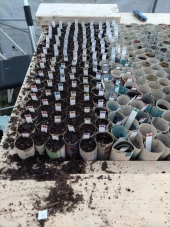posted 4 years ago
Cris,
Others have made very good points here. I like Anne’s suggestion about using daikon radish to improve the soil.
I think that if you are going to build a new garden bed, there are basically two options—go down or go up.
Normally I would recommend going no-till on a new garden. I believe that all fertility begins with the health of the soil and thus I would disturb it as little as possible. But in your case, if you have actual construction debris, bricks especially, it may be worthwhile to either make a single deep tillage pass once to get rid of the debris or go digging to find those bricks and get them out. So maybe dig/till once if you want to go down.
If you want to go up, have you thought about raised beds? All my garden beds are raised up with 2x10’s laid on edge, so they are raised just shy of 1 foot. Going up takes more up front work and is more expensive, but my beds, while smaller, are more productive than when I had beds in the ground. I fill my beds with wood chips and break them down with mushrooms (Wine Caps). The decaying wood drastically improves the soil beneath and the plants love me for it.
I have blathered on about wood chips and Wine Caps again, but I would still use a similar approach to a bed in the ground, whether you make one tillage pass or not. Organic material on the surface does wonders for the soil below with the help of microbes.
So really either/all is your choice. I would certainly not blame you for getting debris out, but after doing that, help the soil heal by getting good organic material on top. By all means, Dr. RedHawk’s soil thread is an amazing resource. Have more questions, please don’t hesitate to ask.
Eric
Some places need to be wild









